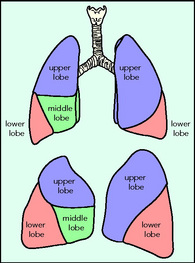Chapter 5 Respiratory system
Important for the examiner is the arrangement of the lobes of the lungs (Fig. 5.1). It will be seen that both lungs are divided into two and the right lung is divided again to form the middle lobe. The corresponding area on the left is the lingula, a division of the upper lobe. Examination of the front of the chest is largely that of the upper lobes, examination of the back is of the lower lobes.
SYMPTOMS OF RESPIRATORY DISEASE
Dyspnoea
CAUSES OF BREATHLESSNESS
Cough
Laryngitis will cause both cough and a hoarse voice. Cough from tracheitis is usually dry and painful. Cough from further down the airways is often associated with sputum production (bronchitis, bronchiectasis or pneumonia). Other possibilities are carcinoma, lung fibrosis and increased bronchial responsiveness. An often overlooked cause of cough is aspiration into the lungs from gastro-oesophageal reflux or a pharyngeal pouch. Cough will then follow meals or lying down. Prolonged coughing bouts can cause both unconsciousness from reduction of venous return to the brain (cough syncope) and also vomiting.
Haemoptysis
The blood in haemoptysis is usually bright red at first, then followed by progressively smaller and darker amounts.
Pain
The lungs and the visceral pleura are devoid of pain fibres, whereas the parietal pleura, chest wall and mediastinal structures are not. The characteristic ‘pleuritic pain’ is sharp, stabbing, worse on deep breathing and coughing and arises from either pleural inflammation or chest wall lesions. Inflammation of the pleura occurs chiefly in pneumonia and pulmonary infarction from pulmonary emboli. Pneumothorax can produce acute transient pleuritic pain.
Other important points in the history
OTHER BODY SYSTEMS
Weight loss is an important manifestation of lung carcinoma. Less well known is chronic airflow limitation, caused presumably by the increased respiratory effort impairing appetite and diverting calories to the respiratory muscles. Chronic infection, particularly tuberculosis, causes weight loss.
Social history
SMOKING
Smoking is, for practical purposes, the cause of chronic bronchitis and carcinoma of the bronchus.
Ask non-smokers: ‘have you smoked in the past?’ The risk of disease increases with the amount smoked. Cigarettes are the most dangerous; pipes and cigars are not free of risk. Risk declines steadily when smoking stops; it takes 10–20 years for the risk of lung cancer to equal that of lifelong non-smokers.


 Questions to ask: Dyspnoea
Questions to ask: Dyspnoea Differential diagnosis: Some causes of breathlessness
Differential diagnosis: Some causes of breathlessness Differential diagnosis: Duration of breathlessness
Differential diagnosis: Duration of breathlessness Questions to ask: Asthma
Questions to ask: Asthma Questions to ask: Sputum
Questions to ask: Sputum Symptoms and signs: Sputum
Symptoms and signs: Sputum Differential diagnosis: Haemoptysis
Differential diagnosis: Haemoptysis Risk factors: Pulmonary embolism
Risk factors: Pulmonary embolism Symptoms and signs: Clinical features suggesting the sleep apnoea syndrome
Symptoms and signs: Clinical features suggesting the sleep apnoea syndrome Risk factors: Lung cancer
Risk factors: Lung cancer

